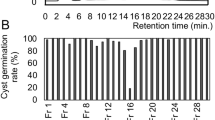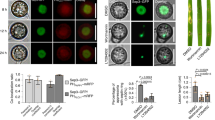Abstract
THE syndrome of senescence or aging is common to all living material. In many fungi the peripheral hyphae become senescent after prolonged vegetative growth, that is, their growth rate decreases and they eventually die. In some fungi, senescence is caused by transmissible elements, of temporarily if their metabolism is drastically reduced1,5, but anastomosis. The onset of senescence is influenced by environmental as well as genetical factors1–6. In Podospora anserina, where senescence has been very thoroughly analysed, it was shown that senescent mycelia may recover temporarily if their metabolism is drastically reduced1,5, the mycelia soon become senescent when grown in normal conditions. The nature of the senescent agent in Podospora is obscure. All efforts to demonstrate viruses or virus-like particles in aging hyphae of Podospora have failed (R. Bozarth, personal communication). Our endeavours to determine the nature and action of the senescent agent were encouraged by previous findings that the onset of senescence can be completely prevented by a synergistic action of specific genes6. In this paper we show that an antibiotic, tiamulin, can mimic the effect of these genes.
This is a preview of subscription content, access via your institution
Access options
Subscribe to this journal
Receive 51 print issues and online access
$199.00 per year
only $3.90 per issue
Buy this article
- Purchase on Springer Link
- Instant access to full article PDF
Prices may be subject to local taxes which are calculated during checkout
Similar content being viewed by others
References
Marcou, D., A. Sci. nat., 653–764 (1961).
Esser, K., and Kuenen, R., Genetics of Fungi (Springer-Verlag, Berlin, New York, 1967).
Bertrand, H., McDougall, K. J., and Pittenger, T. H., J. gen. Microbiol., 50, 337–350 (1968).
Holliday, R., Nature, 221, 1224–1228 (1969).
Smith, J. R., and Rubenstein, I., J. gen. Microbiol., 76, 283–296 (1973).
Esser, K., and Keller, W., Molec. gen. Genet., 144, 107–110 (1976).
Razin, S., Adv. Microbiol. Physiol., 10, 1–80 (1973).
Smith, P. F., The Biology of Mycoplasms (Academic, New York, 1972).
Ross, I. K., Pommerville, J. C., and Damm, D. L., J. Cell Sci., 21, 175–191 (1976).
Author information
Authors and Affiliations
Rights and permissions
About this article
Cite this article
ESSER, K., TUDZYNSKI, P. Prevention of senescence in the ascomycete Podospora anserina by the antibiotic tiamulin. Nature 265, 454–456 (1977). https://doi.org/10.1038/265454a0
Received:
Accepted:
Published:
Issue Date:
DOI: https://doi.org/10.1038/265454a0
This article is cited by
-
Transcription of a mitochondrial plasmid during senescence in Podospora anserina
Current Genetics (1983)
-
A model to explain senescence in the filamentous fungus Podospora anserina by the action of plasmid like DNA
Molecular and General Genetics MGG (1980)
-
Chromosomal and extrachromosomal control of senescence in the ascomycete Podospora anserina
Molecular and General Genetics MGG (1979)
-
Lethal mitochondrial genotypes in Podospora anserina: A model for senescence
Molecular and General Genetics MGG (1978)
-
Evidence for plasmid like DNA in a filamentous fungus, the ascomycete Podospora anserina
Molecular and General Genetics MGG (1978)
Comments
By submitting a comment you agree to abide by our Terms and Community Guidelines. If you find something abusive or that does not comply with our terms or guidelines please flag it as inappropriate.



